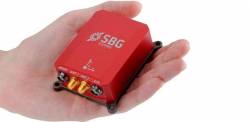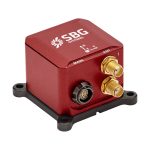 Ellipse-D inertial navigation system. Photo source: SBG Systems.
Ellipse-D inertial navigation system. Photo source: SBG Systems.VIAMETRIS has chosen the Ellipse-D inertial navigation system from SBG Systems to equip their new SLAM-based mobile mapping system: the vMS3D. The vMS3D is a complete mobile mapping solution which combines inertial, GNSS, and SLAM technologies designed to offer an economical option with optimal performance.
VIAMETRIS has chosen the Ellipse-D inertial navigation system from SBG Systems to equip their new SLAM-based mobile mapping system: the vMS3D. The vMS3D is a complete mobile mapping solution which combines inertial, GNSS, and SLAM technologies designed to offer an economical option with optimal performance.
VIAMETRIS is a precursor in the development of SLAM-based solutions. Two years ago, the company, with offices in Louverné, France and Clearwater, Florida, USA, released the iMS3D, an indoor mapping system based on the SLAM technology. Capitalizing on this experience, the company has just launched a new solution: the vMS3D.
vMS3D looks like a classic Mobile Mapping System (MMS). It integrates a 360° camera, a rotating LiDAR, and an internal navigation system with GNSS receiver. The straightforward automatic workflow does not show the subtle and yet sophisticated internal computation that makes it unique, according to the company. The vMS3D is equipped with an additional LiDAR used for SLAM computation. After the acquisition, the post- processing software — named PPiMMS — automatically analyses the situations where GNSS is sufficient, where inertial is preferred, or where SLAM is required.
The vMS3D solution is designed to take into account the advantages and disadvantages of each technology, depending on their conditions of use. When the GNSS receiver provides reliable data, for instance in open sky environment, the solution simply relies on its position. If a GNSS outage or disturbance occurs, the system then chooses between inertial or SLAM-based data. Position computed from SLAM is preferred in dense environments where surrounding objects are very diverse and close, such as in urban canyons or forests. SLAM capabilities are limited in environments where objects are too far or not distinguishable. Velocities and orientation information provided by the Inertial Navigation System (INS) are then able to assist the navigation in all the cases where GNSS and SLAM are limited. Performance can also be improved with the use of odometer, and ground control points.
Already quite satisfied with the Ellipse for his indoor iMS3D, Jérôme Ninot, the founder of VIAMETRIS, did not look so far to select an INS for his new project. “Ellipse INS provides very, very precise velocity data”, Ninot said.
The SLAM computation allows VIAMETRIS to rely on miniature and cost-effective inertial sensors while other systems on the market require higher accuracy inertial systems, VIAMETRIS states. Ellipse sensors deliver 0.1° accurate attitude, and Ninot also chose the Ellipse-D model for the all-in-one and miniature form factor, and the embedded RTK GNSS receiver. “With an integrated INS like the Ellipse-D, offering a single communication interface and built-in synchronization to the GNSS and LiDAR, we have been able to concentrate on our SLAM expertise,” adds the CEO, before mentioning that less cable is always a good choice.
Ellipse-D, the Multi-Task INS
Integrated into this solution, the Ellipse-D performs several tasks. First, it provides roll and pitch to constraint all LiDAR data, so the point cloud is referenced at ground level. Secondly, Ellipse-D turn rates are very helpful, especially when an abrupt change of direction occurs. Indeed, orientation compensation is required between two scans when the LiDAR is in motion. Finally, Ellipse-D fuses in real time inertial and GNSS information to provide excellent velocity measurements which are also very important to continuously assist vMS3D internal algorithms, states Rueil-Malmaison, France-based SBG Systems.





